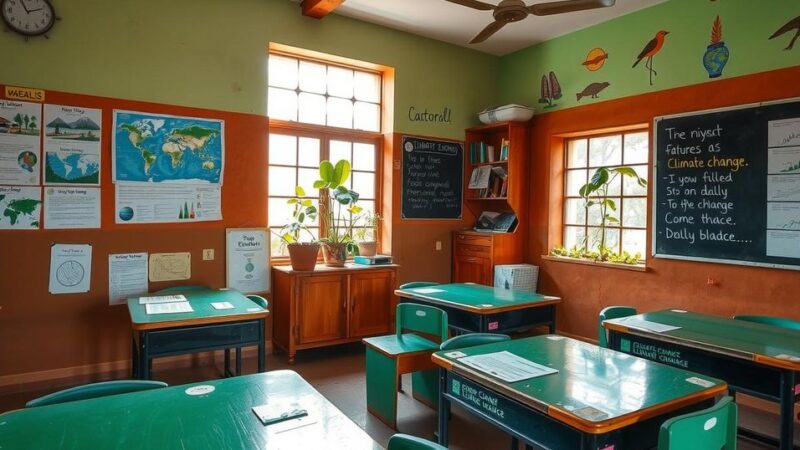Climate change is critically impacting cacao trees, leading to increased chocolate prices and highlighting the necessity for sustainable cocoa practices. The effects include rising temperatures and humidity causing disease outbreaks, which devastate cacao crops. In response, stakeholders in the U.S. and Europe are advancing sustainable cocoa solutions to address these challenges and improve farmer livelihoods.
Climate change poses a significant threat to cacao trees, consequently increasing chocolate prices and highlighting the urgent need for sustainable cocoa practices in the United States and Europe. Rising temperatures, combined with increased humidity from rainfall, are altering the vital environmental conditions necessary for cacao cultivation within the tropical belt spanning 40 degrees of latitude around the equator. This region, home to the majority of the world’s cocoa farmers—predominantly located in Brazil, Cameroon, Côte d’Ivoire, the Dominican Republic, Ecuador, Ghana, Indonesia, Nigeria, and Peru—produces approximately 90% of the annual five million tonnes of cocoa beans. Cacao trees are particularly susceptible to environmental changes and do not thrive under fluctuating and extreme weather conditions, leading to the challenges faced by farmers and the cocoa industry at large. It typically takes three years after planting for new cacao trees to yield beans. In key countries like Côte d’Ivoire and Ghana—responsible for more than half of the global cocoa production—climate change has fostered conducive conditions for mealybug populations, which exacerbate issues by introducing a lethal swollen shoot virus that has already claimed an estimated 200 million cacao trees, as per the National Oceanic and Atmospheric Administration (NOAA). This devastation has directly resulted in rising cocoa bean prices. Furthermore, NOAA highlights the role of heightened heatwaves and heavy rainfall in promoting the spread of black pod disease, another threat to cacao trees. Recent statements from the United Nations Conference on Trade and Development (UNCTAD) have emphasized alarming trends in cocoa prices, noting a historic increase in cocoa futures, which reached an unprecedented $10,000 per metric tonne. UNCTAD reports that “Extreme weather and changing climate patterns have upended crop harvests, which are expected to fall short for the third year in a row, tightening global supplies and raising prices. The cost of cocoa, the key ingredient for making the beloved sweets, shot up by 136% between July 2022 and February 2024.” In response to these challenges, stakeholders in the U.S. and Europe—principal markets for chocolate products—are exploring sustainable cocoa solutions. Notably, the U.S. Agency for International Development initiated a project with Indonesia in 2023, aimed at training 6,500 cocoa and coffee farmers in sustainable agroforestry techniques in regions such as East Nusa Tenggara, North Sumatra, and South Sulawesi. This project seeks to mitigate the impacts of climate change by promoting crop diversification and enhancing tree health amidst declining yields. The United States plays a crucial role in the global chocolate market, with significant trade figures reflecting its importance, having imported $3.9 billion and exported $1.9 billion worth of chocolate and cocoa products in 2023, as reported by the U.S. Department of Agriculture. Canada, Mexico, and Vietnam are among the top importers of American chocolate products. Europe, similarly invested in sustainable cocoa, is exemplified by initiatives such as Germany’s “German Initiative on Sustainable Cocoa,” which aspires to improve farmers’ conditions while exclusively sourcing sustainable cocoa. As of 2023, Germany has reportedly achieved a significant milestone, with 92.2% of sustainably produced cocoa sweets sold by initiative members. Meanwhile, the Swiss Platform for Sustainable Cocoa aims for 80% of Swiss cocoa imports to come from sustainable sources by 2025. In conclusion, raising awareness about sustainable cocoa practices transcends mere market dynamics, offering a framework for significantly improving the livelihoods of cocoa farmers and their communities. By prioritizing sustainability and collaboration between stakeholders, the chocolate industry can help combat the adverse effects of climate change while ensuring the future availability of cocoa beans.
The interplay between climate change and cocoa production is increasingly evident as environmental disruptions threaten the survival of cacao trees, which are particularly sensitive to temperature and humidity fluctuations. With the majority of cocoa production concentrated in a limited geographic area, the sustainability of this essential crop is becoming a pressing concern. The increasing incidence of pests, diseases, and extreme weather patterns due to climate change directly impacts yield and farmer livelihoods, thereby raising cocoa prices and prompting immediate action for sustainable farming practices.
The rising cocoa prices and their connection to climate change illustrate a critical challenge for the chocolate industry, emphasizing the urgent need for sustainable agricultural practices. By investing in sustainable cocoa initiatives, stakeholders can not only address the pressing challenges posed by climate change but also ensure the economic viability of cocoa farmers, ultimately benefiting consumers and the environment.
Original Source: www.forbes.com






